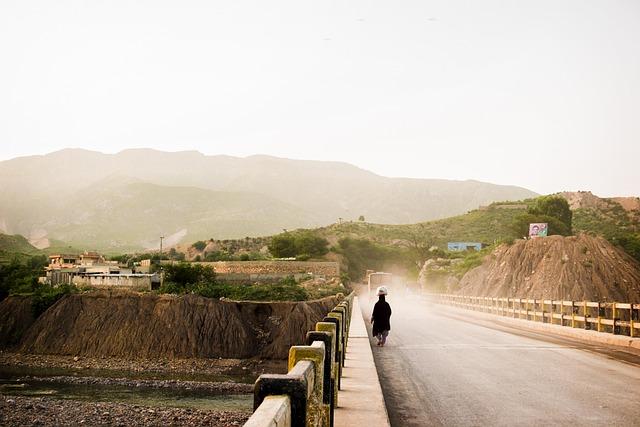In an era where global development hinges on the strength and resilience of infrastructure, Pakistan stands at a pivotal crossroads. With its rich tapestry of culture and resources, the nation possesses the potential to transform its infrastructure landscape into a beacon of progress. However, the road to revitalization is fraught with challenges—from aging roads and unreliable energy sources to an urgent need for urban planning and sustainable solutions. This article delves into the multifaceted pathways that could lead to the rejuvenation of Pakistan’s infrastructure, highlighting innovative strategies, collaborative ventures, and the critical role of investment in building a robust foundation for the future. As the nation embarks on this journey of renewal, understanding the intricate connections between infrastructure and economic prosperity becomes essential in unlocking the true potential of a thriving Pakistan.
Transforming Urban Centers Through Smart City Initiatives
In a rapidly urbanizing world, cities are increasingly embracing technology to enhance the quality of life for their residents. Smart city initiatives provide robust frameworks that can lead to improved traffic management, sustainable energy solutions, and advanced public safety measures. By integrating Internet of Things (IoT) devices and data analytics, urban centers can effectively manage resources while addressing the growing demands of their populations. Key components of these initiatives may include:
- Intelligent Transportation Systems: Utilizing real-time data to optimize traffic flow and reduce congestion.
- Waste Management Innovations: Implementing smart bins that monitor waste levels and streamline collection routes.
- Green Energy Solutions: Installing smart grids to promote the use of renewable energy sources and enhance energy efficiency.
- Community Engagement Platforms: Creating mobile apps that enable citizens to participate in local governance and report issues efficiently.
The transformation of urban centers is not just about technological advancement; it’s also about fostering inclusivity and resilience. Smart cities are envisioned as spaces where all citizens can benefit from enhanced services and amenities. This can be achieved through initiatives that focus on digital literacy, ensuring that community members can leverage smart technologies to improve their lives. Steps such as:
| Initiative | Description |
|---|---|
| Digital Literacy Programs | Workshops to educate citizens about technology use and online safety. |
| Access to Public Wi-Fi | Free internet access in public spaces to bridge the digital divide. |
| Public Feedback Mechanisms | Platforms to voice opinions and participate in civic decision-making. |
This holistic approach not only revitalizes infrastructures but also nurtures community spirit and economic development, ultimately paving the way for a brighter future in urban Pakistan.

Enhancing Transportation Networks for Economic Growth
In the ever-evolving landscape of global economies, the significance of well-structured transportation networks cannot be overstated. A robust infrastructure serves as the backbone of economic activity, offering businesses the agility they need to thrive. By focusing on integrating roadways, railways, air routes, and inland waterways, Pakistan can unlock pathways that not only enhance connectivity but also stimulate regional and international trade. Key investments in modernizing existing systems and introducing advanced logistics technologies will lead to reduced transit times and lower costs, thereby attracting both domestic and foreign investments.
Furthermore, prioritizing sustainable transportation solutions can yield multifaceted benefits for the nation. Initiatives such as the development of electric public transport systems and expansion of cycling networks can mitigate environmental impact while promoting healthier lifestyle choices among citizens. Emphasizing public-private partnerships can be pivotal in financing large-scale infrastructure projects, ensuring that communities are equipped with reliable transportation options. To illustrate the potential impact, consider the following table showcasing projected benefits of enhanced transportation networks:
| Benefit | Projected Impact |
|---|---|
| Job Creation | Over 1 million new jobs |
| GDP Growth | Increase by 2% annually |
| Trade Volume | Export growth of 20% |

Strengthening Energy Infrastructure for Sustainable Development
In an era where sustainable development is paramount, enhancing energy infrastructure is crucial for fostering economic growth and improving the quality of life in Pakistan. A modernized energy sector can reduce reliance on fossil fuels, increase energy efficiency, and ensure a reliable supply of electricity to underserved regions. To achieve these goals, the country must focus on integrating renewable energy sources, such as solar and wind, into the national grid, as well as investing in smart grid technologies that enhance energy management and distribution.
Key strategies for bolstering energy infrastructure include:
- Investment in Renewable Energy: Prioritizing the development of solar and wind farms to harness the country’s abundant natural resources.
- Enhancement of Grid Capacity: Upgrading transmission infrastructure to cope with increased power generation and demand.
- Implementation of Energy Storage Solutions: Utilizing battery technology to store surplus energy for peak consumption times.
- Promoting Energy Efficiency: Encouraging industries and households to adopt energy-saving practices and technologies.
| Renewable Energy Source | Potential Capacity (MW) |
|---|---|
| Solar | 50,000 |
| Wind | 11,000 |
| Hydropower | 30,000 |
By revitalizing the energy infrastructure, Pakistan can pave the way for innovative solutions that align with global sustainability goals. Engaging stakeholders through public-private partnerships and community involvement will be essential to ensure that the initiatives are inclusive and beneficial for all citizens. Furthermore, adopting policies that promote financing and technology transfer will enhance the growth of renewable energy installations, making the country a leader in sustainable energy development in the region.

Promoting Public-Private Partnerships to Drive Innovation and Investment
In the quest to modernize Pakistan’s infrastructure, public-private partnerships (PPPs) can play an instrumental role in fostering innovation and attracting investment. By facilitating cooperation between government bodies and private enterprises, PPPs offer a dynamic approach to address infrastructure challenges and optimize resource allocation. Their collaborative nature can result in the implementation of cutting-edge technologies and innovative solutions that might otherwise be unattainable. Essential areas ripe for PPP involvement include:
- Transportation networks: Enhancing roadways, rail systems, and airport facilities.
- Urban development: Revitalizing cities with sustainable housing and public spaces.
- Energy generation: Leveraging private investment for renewable energy projects.
- Water supply and sanitation: Collaborating to improve public health infrastructure.
Moreover, these partnerships can significantly reduce the financial burden on the public sector while ensuring accountability and efficiency. By structuring agreements that align private sector objectives with public interests, stakeholders can create a win-win scenario. To illustrate the potential impact of strategic partnerships, consider the following table highlighting key projects and their anticipated benefits:
| Project | Key Benefits |
|---|---|
| Metro Rail Systems | Reduced traffic congestion; lower emissions |
| Smart Water Management | Efficient resource usage; improved public health |
| Renewable Energy Farms | Energy independence; job creation |
| Urban Transit Solutions | Enhanced accessibility; economic development |
Future Outlook
As we stand at the crossroads of opportunity and necessity, the revival of Pakistan’s infrastructure is not merely a project—it is a powerful catalyst for growth, innovation, and unity. Embracing sustainable practices and leveraging technology can transform our roads, bridges, and urban spaces into conduits of progress that connect communities and uplift lives.
The journey ahead requires collaboration among government, private sectors, and citizens alike—each contributor playing a pivotal role in shaping a resilient infrastructure framework. Through strategic investments, meticulous planning, and a commitment to inclusivity, we can pave the way for a brighter, more sustainable future.
As we envision the Pakistan of tomorrow, let us remember that every initiative taken to revitalize our infrastructure is a step toward empowering future generations. By nurturing the foundations of our nation, we can create ripple effects that resonate far beyond brick and mortar, fostering a legacy of progress for all. With collective determination and a shared vision, the pathways we forge today will lead to a flourishing tomorrow—one where Pakistan stands tall on the global stage, a testament to the power of renewal and ambition.



